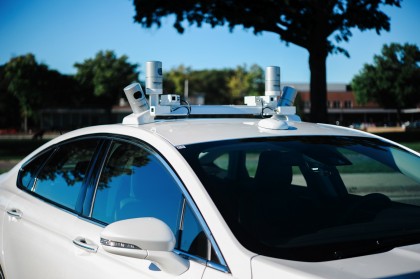Here's what it's like to ride in Ford's self-driving car
An autonomous Ford Fusion Hybrid took us for a spin... and we survived!

We felt the car brake unnecessarily hard just once as it approached an intersection, but the engineers did confess that our model was tuned to be "conservative" in those situations -- fast-forward five years, and they'll have that algorithm ironed out.
The only quirk we saw in its decision making came at a point where we needed to make a left turn in order to get back to the parking lot from which we left. We approached a four-way intersection where a Mustang pulled up to its stop sign at roughly the same time as us. The car is designed to wait a comically long amount of time in these scenarios in order to give human drivers the right-of-way, but the Mustang's driver was far too polite.

Eventually, our autonomous Fusion Hybrid began to carry through with its turn, but it seemed to get spooked halfway through and began to accelerate. Our engineer quickly took the wheel and ensured that all ended well, but that quirk uncovered an amazing reality that we'd not yet heard about.
We were told that every single drive is logged, so engineers will be able to dump the data from our particular trip and drill down on what its logic was in that final intersection. Better still, Ford's gurus can actually see what the car would have done had our driver not intervened. Perhaps it would've completed the turn, albeit in a herky-jerky manner. Perhaps it would've crashed. The cool part is that we know -- well, the engineers do, anyway.

Even though neither happened, the folks perfecting this technology can peer into a parallel universe in order to better understand how their cars are thinking and reacting. That's golden when it comes to tweaking algorithms and building towards a fault-free future.
An interview with Mark Fields

We were able to grab a few minutes with Ford's CEO, Mark Fields. We asked him what challenges remain before Ford can roll self-driving cars out to the public, and his response was fairly surprising. He isn't waiting around for infrastructure to be ready. He isn't counting on dedicated self-driving car lanes on freeways. He'd rather invest in building a revolutionary self-driving car that's capable enough to drive itself on roads with maniacs like us, which is as bold as it is awesome.

It's going to be a lot harder to build an autonomous fleet that doesn't (necessarily) use connected roadways or IoT innovations, but it's also the most direct route to adoption. If you build something solid and smart enough, and it's able to integrate with driven vehicles, you're apt to catch the attention of the mainstream.
Sign up for breaking news, reviews, opinion, top tech deals, and more.

Speaking about the upcoming changes to infotainment systems in self-driving cars, he stated that Ford isn't singling out the dashboard. "When the driver becomes the rider," he said, "you're able to rethink the entire interior, infotainment included." In other words, Mr. Suit may order a self-driving Ford with a "Business" interior, whereas a rave-happy teenager may pine for an interior that's more amenable to being... shall we say, a rolling party.

Eventually, you may be able to order a car with a themed interior as easily as you can order different tires for off-roading, winter driving, or track use.
When can you buy one?

Unfortunately, it's unclear how soon Ford will offer a car on dealer lots that lacks a steering wheel, gas pedal, and brake pedal. According to our chat with Fields, the goal is to have a fully autonomous fleet of cars shuttling employees around Ford's various campuses by 2018, and then a fleet being used in ride-hailing services by 2021. Fields stressed that Ford is committed to working with cities in order to relieve congestion and commute frustration first.

Those routes are highly predictable, (relatively) easy to map, and fairly resistant to deviation. A car departing a customer's garage, however, is far more capable of going way off of the grid -- that's the primary reason why it'll be many years before Ford is comfortable selling these to end users. Despite being pressed, Fields also wouldn't put a pricing figure on things. He did confess, however, that Ford is doing everything it can to lower pricing so that laypeople can afford self-driving cars.

Ford's history has been one of putting outstanding tech in the hands of many, not just a few, and its eventual fleet of autonomous cars shouldn't be any different. And if it allows us to sleep, work, and even work out during a two-haul to the airport, well, let's just say it'll be tough to ignore that kind of value proposition.
- Are we there yet? The reality of the driverless car revolution
